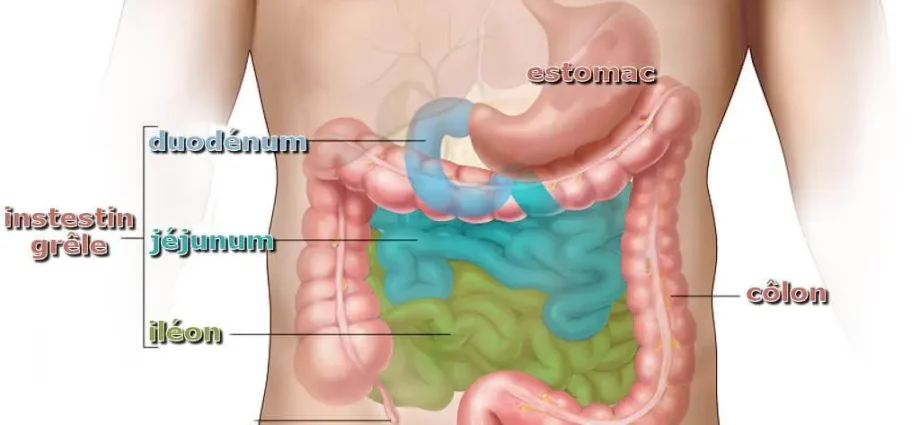Contents
Iléon
The ileum (from medieval Latin ileum, from the Greek eileîn, meaning “to roll”) is a part of the small intestine, an organ of the digestive system.
Anatomy of the ileum
Position. The ileum is the part of the small intestine following the jejunum and extending to the ileocecal valve, leading to the large intestine.
Structure of the ileum. It is one of the three segments of the small intestine (the duodenum, jejunum and ileum). 5-7 m long and 3 cm in diameter, the small intestine follows the stomach and is extended by the large intestine (1). The ileum and jejunum make up most of the small intestine and the mobile part of the small intestine (1) (2).
Structure of the ileum wall. The ileum is made up of 4 envelopes (1):
- The mucous membrane is the inner layer, containing many glands secreting in particular a protective mucus.
- The submucosa is the intermediate layer made up in particular of blood vessels and nerves.
- The muscularis is the outer layer made up of muscle fibers.
- The serous membrane, or peritoneum, is an envelope lining the outer wall of the small intestine.
Physiology / Histology
Digestion. Digestion takes place mainly in the small intestine, and more particularly in the duodenum through digestive enzymes and bile acids. Digestive enzymes originate from the pancreas through the excretory ducts, while bile acids originate from the liver through the bile ducts (3). Digestive enzymes and bile acids will transform chyme, a liquid comprising food pre-digested by digestive juices from the stomach, into chyle, a clear liquid containing dietary fibers, complex carbohydrates, simple molecules, as well as as nutrients (4).
Absorption. For its activity, the body will absorb certain elements such as carbohydrates, fats, proteins, electrolytes, vitamins, as well as water (5). Most of the digestion products are absorbed in the small intestine, and the ileum plays a key role in the absorption of vitamin B12 and bile salts (5).
Protection of the small intestine. The ileum defends itself against chemical and mechanical attacks by secreting mucus, protecting the mucous membrane (3). At the level of the ileum, the small intestine is also protected from the contamination of bacteria of the large intestine thanks to the ileocecal valve. The latter opens to allow the chyle to pass to the cecum, the first part of the large intestine, and closes to prevent backflow of the chyle to the ileum.
Pathologies associated with the ileum
Chronic inflammatory bowel disease. These diseases correspond to inflammation of the lining of part of the digestive system, such as Crohn’s disease. Symptoms include severe abdominal pain and diarrhea (6).
Irritable bowel syndrome. This syndrome is manifested by hypersensitivity of the wall of the intestine, especially in the ileum, and irregularity in muscle contractions. It manifests itself through various symptoms associated with digestive disorders such as diarrhea, constipation, or abdominal pain. The cause of this syndrome is still unknown today.
Bowel obstruction. It indicates a stop of the functioning of the transit, causing intense pain and vomiting. Intestinal obstruction can be of mechanical origin with the presence of an obstacle during transit (gallstones, tumors, etc.) but can also be chemical by being linked to an infection of a nearby tissue, for example during peritonitis.
Treatments
Medical treatment. Depending on the pathology diagnosed, certain drugs may be prescribed such as anti-inflammatory drugs or analgesics.
Surgical treatment. Depending on the pathology and its evolution, a surgical intervention may be implemented.
Ileum examination
Physical examination. The onset of pain begins with a physical examination to assess symptoms and identify the causes of the pain.
Biological examination. Blood and stool tests may be done to make or confirm a diagnosis.
Medical imaging exam. Depending on the suspected or proven pathology, additional examinations may be performed such as an ultrasound, a CT scan or an MRI.
Endoscopic examination. An endoscopy can be done to study the walls of the ileum.
History
In 2010, researchers from Inserm in Nantes published their research results on the effects of Parkinson’s disease on digestive neurons in the scientific journal Plos One. They have shown that the lesions of Parkinson’s disease affect not only the cells of the central nervous system, but also those of the enteric nervous system, and more precisely that of the digestive system. This discovery could allow an early diagnosis of Parkinson’s disease (7).










